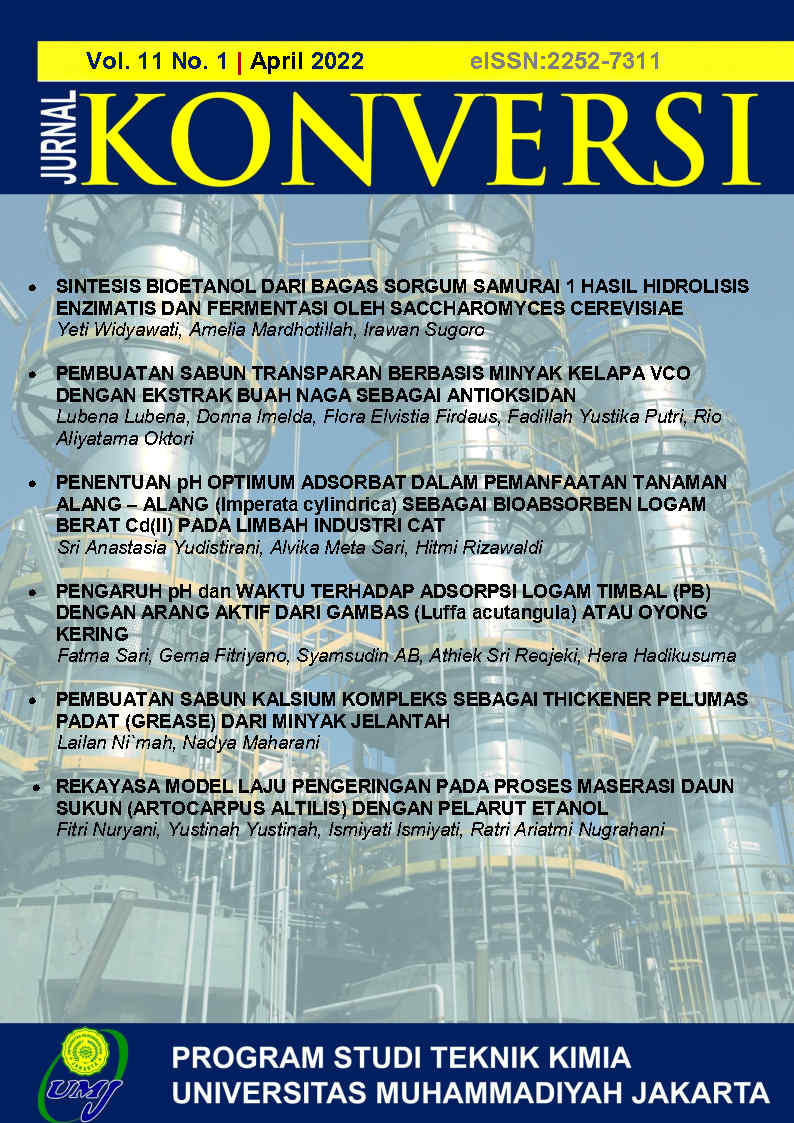REKAYASA MODEL LAJU PENGERINGAN PADA PROSES MASERASI DAUN SUKUN (ARTOCARPUS ALTILIS) DENGAN PELARUT ETANOL
Main Article Content
Abstract
Article Details
Authors who publish with this journal agree to the following terms:
- Authors retain copyright and grant the journal right of first publication with the work simultaneously licensed under a Creative Commons Attribution License that allows others to share the work with an acknowledgement of the work's authorship and initial publication in this journal.
- Authors are able to enter into separate, additional contractual arrangements for the non-exclusive distribution of the journal's published version of the work (e.g., post it to an institutional repository or publish it in a book), with an acknowledgement of its initial publication in this journal.
- Authors are permitted and encouraged to post their work online (e.g., in institutional repositories or on their website) prior to and during the submission process, as it can lead to productive exchanges, as well as earlier and greater citation of published work (See The Effect of Open Access).
References
Rasyadi Yahdian, 2018, “Formulasi Sediaan Kumur dari Ekstrak Daun Sukun Artocarpus altilis (Parkinson ex F.A.Zorn) Fosberg”, Volume 3 no 2 , Chempublish Journal : 76-84.
A. Vervelle,J. Mouhyi,M. Del Corso,M.-P. Hippolyte,G. Sammartinod,D.M. Dohan Ehrenfest, 2010, “Mouthwash solutions with microencapsuled natural extracts: Efficiency for dental plaque and gingivitis”, Elsevier Masson.
Utami, 2013, “Fisiologi Tanaman”, Bumi Aksara, Jakarta.
Mierziak, J., Kostyn, K., Kulma, A., 2014, “Flavonoids as important molecules of plant interactions with the environment”, Basel Switz (19): 16240–16265.
Uzel, A., Sorkun, K., Onçağ, O., Cogŭlu, D., Gençay, O., Salih, B., 2005, “Chemical compositions and antimicrobial activities of four different Anatolian propolis samples”, Microbiol(Res 160): 189–195.
Syahri, L, 2016, “Pengaruh Fraksi Etil Asetat Ekstrak Etanol Buah Kemukus (Piper cubeba L.) Fructus Terhadap Memori Spasial Tikus jantan Galur Wistar Pasca Restraint Stress”, Semarang.
Agoes.G, 2007, “Teknologi Bahan Alam”, ITB Press Bandung.
Seidel V., 2006, “Initial and bulk extraction”, In Sarker SD., Latif Z., & Gray AI., editors, Natural Products Isolation, 2nd ed, Totowa (New Jersey), Humana Press Inc: 31-5.
Heinrich M., J. Barnes., S. Gibbons dan E.M., Williamson, 2005, “Farmakognosi dan Fitoterapi”, Penerbit Buku Kedokteran EGC.
Widartun Sri., Ike Yulia., Aditya Aprizayansyah, 2016,“ Flavonoid Ekstrak Metanol dan Ekstrak Etil Asetat Daun Sukun dan Aktifitasny terhadap Penurunan Kadar Glukosa Secara In Vitro”, Vol.6, No.2, Fitofarmaka.
A.Trihadi Kusuma., Andi Adelah., Zainal Abidin., Ahmad Najib, 2018, “Penentuan Kadar Flavonoid Ekstrak Etil Asetat Daun Sukun (Artocarpus altilis)”, vol 1 no 1, makasar.
Rizema, S. 2013. Ajaibnya Daun Sukun Berantas Berbagai Penyakit. Flash Books. Yogyakarta.
Seidel V., 2006. Initial and bulk extraction. In: Sarker SD, Latif Z, & Gray AI, editors. Natural Products Isolation. 2nd ed. Totowa (New Jersey). Humana Press Inc. hal. 31-5.
Mardiana. 2013. Daun Ajaib Tumpas Penyakit. Penebar Swadaya. Jakarta. (Hal 11, 28, 39, 44)
